Last Updated on May 13, 2023 by
This is your ultimate guide to deer hunting in Australia.
Many species were released into Australia in 1800-1900, but not all survived the harsh Australian environment.
Six deer species, however, adapted easily to the Australian bush and are now thriving wild populations. Due to the vast expanses in the Australian bush, there may be many more species that went unnoticed.
Australia’s Acclimatization Era
Some of the six species are descendants from the original species that were released in the acclimatisation period, while others have escaped modern deer farms. These deer are now more free to roam Australia than ever before.
Deer are a great animal to hunt. They are plentiful and easy to find. For information on how to prepare deer meat for consumption, see our guide for skinning deer.
Below is a guide that outlines the appearance and demeanors of all the species currently found wild in Australia.
Sambar deer (Cervus unicolour)
Sambar deer are Australia’s most beloved game animal. Sambars are a powerful and intelligent game deer that is a challenge to deer hunters.
Sambar were introduced in Victoria around 1850. They were then released at several checkpoints throughout the territory and Victoria. The sambar is abundantly hunted in Victoria. Its thick population can be found along the Great Dividing Range, as well as other areas of NSW.
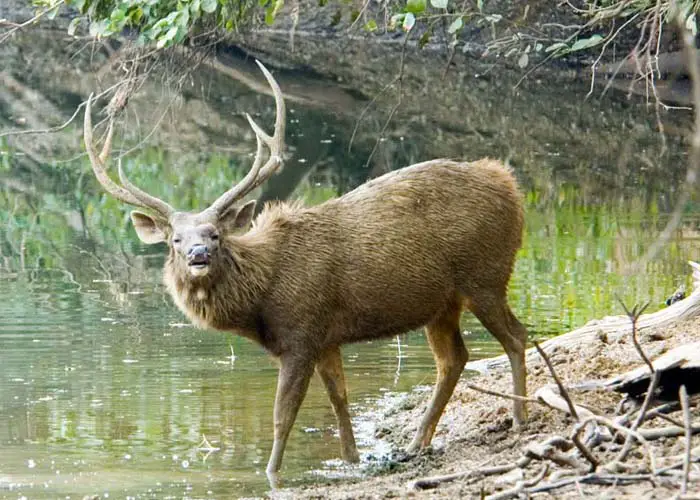
Appearances of the Sambar Deer
The sambar stag is large in stature and can weigh up to 220kg. It can also stand up to 125cm tall (to the shoulder). Their coats range from a dull brown color to light grey. Some animals are spotted with darker coats. Their bellies are reminiscent of old straw, and their tails have long orange hairs. They blend well with the colours found in the Australian forests and mountains, giving them an advantage when trying to evade hunters.
Six-pointed sambars have antlers that are six inches long and feature a V-shaped formation. They can be short with antlers that are shorter or wider as they age. Mature stags can be difficult to hunt, with antlers greater than 76cm being a great prize.
Hunting Sambar Deer In Australia
Sambar deer rarely congregate in groups, but they can sometimes coexist with small groups during antler growth. Stags are mostly solitary animals. It is important to learn about the Sambar’s feeding habits and to research the best hunting times.
Sambar eat both introduced and native plants. This can help you to track these deer and give you an edge in hunting. Sambar hunting requires perseverance. Active hunting is best followed closely by stalking. Standing hunting requires more in-depth knowledge and commitment.
The minimum legal calibre for Sambar is.270, while more experienced hunters opt for a higher calibre like.375 Winchesters or.457 Winchesters.
Fallow deer (Dama dama)
The fallows can be found all over the globe and were introduced to Australia in 1830’s. They have established herds in five states.
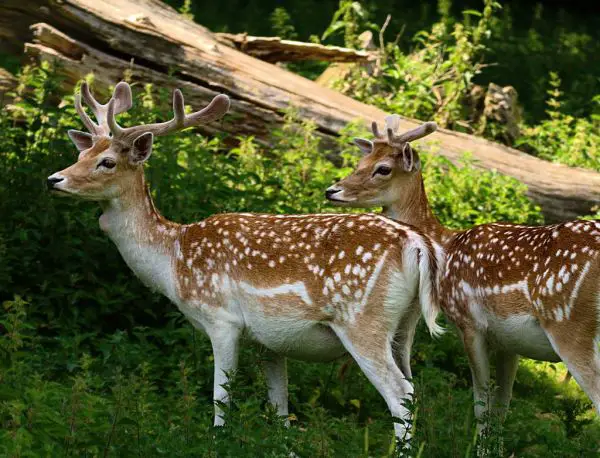
Appearances of the Fallow Deer
The Fallow are known for their varied coat colours, which include black, white and grey/brown. The fallow can develop spots on their coats in winter, while those with light brown coats have been known to have spots throughout the year.
The Fallow graze mainly in wooded areas. However, they can also be found in open country. Most successful herds prefer forested areas. The Fallow prefer areas with bracken ferns and wattles, making them very comfortable in Australia.
Hunting the Fallow Deer In Australia
Fallow bucks have an impressive set of antlers. They appear to be flat above the second tine and have a palm-like appearance. A prize kill is a buck that has antlers 60 cm in length. Fallow hunting is best done in April, when the bucks are more easy to find because of their mating call. However, bucks will fight for territory and mates more frequently during this period and their antlers can be damaged.
Doves tend to be close to their buck, and may warn him about approaching hunters. So stealth must be your priority. Stand hunting is a great way to capture Fallows if you are a patient hunter. Bucks often have a consistent pattern of behavior and movement. These animals aren’t too large, and a smaller calibre like a.243 is usually sufficient to capture one.
Red deer (Cervus elaphus)
The introduction of red deer to Australia in the middle of the 19th century was a result of its origins as a game animal from England. Red deer are the largest and most powerful in QLD. Many reds have been kept for farming in the past, which has resulted in them living in areas they weren’t meant to.
Red deer are a tough animal that can survive in any environment, from dense jungle to open scrub to grasslands. They can survive in the most harsh environments, even though they prefer spaces that are only partially wooded.
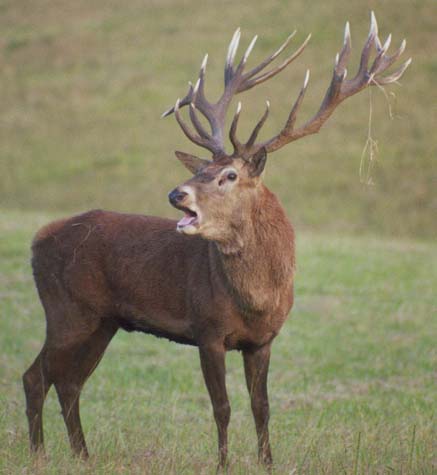
Appearances of the Red Deer
The reds are big and can weigh up 160kg. They come in a variety of colours, from light red to dark. You can identify them by the buff-coloured patches that run along the neck, rump, and face. Their 12 pointed antlers can reach up to 75 cm in length.
Hunting Red Deer in Australia
Reds are more comfortable congregating in groups of at least a dozen animals, often led by a dominant hind. Although bachelor herds are common, they usually disappear once the males reach adulthood and want their own territory. Due to their loud mating calls, stags are easy to find. The red deer is believed to have originated in the Scottish highlands. They are known for their keen sense of smell and hearing. Poor eyesight can make this difficult so hunters are able to take a steady, quiet approach when coming downwind.
Reds can usually be taken down using a.270 Winchester and a Telescopic Sight.
Rusa deer (Cervus timorensis)
The Rusa is an introduced species. They arrived in Australia in 1860. They were then introduced to VIC, WA, and NSW in 1885.
The introduction of the NSW was a huge success in comparison to other states. They have not been reduced by trapping, bushfires or poaching.
Popular deer have expanded their range by moving closer to humans, breeding in Sydney and Wollongong and working their way south along coastal ranges towards Victoria.

Appearances of the Rusa deer
Rusa can also be hunted on private land on the NSW coast and in a few locations in QLD. Although the Rusa is related to the Sambar, they don’t grow as big as the former. The Rusa has a coarse, brownish-grey coat with a buff undercoat. It can only weigh 140kg.
Hunting Rusa Deer in Australia
Although they can thrive in many habitats, the Rusa deer prefers areas with both grass and bush. Their antlers can grow to as high as 70cm, making them a prize kill. The rusa is a herd animal and tends to gather in larger groups. They communicate quite loudly with one another, especially during the July/August period when their terrotories are declared.
Rusa deer breeds are best hunted in the wind, using as much cover and the Rusa’s predicted movements as a guide. Although.270 Winchester is the minimum recommended calibre, many deer have been shot with a lower caliber.
Axis or Chital Deer (Axis Axis)
With records going back to 1803, Chital deer was one of the first species introduced to Australia. They were first released into NSW. Later, they were introduced to QLD and Victoria. The QLD release was the most successful. The herds have grown strong and are largely dependent on private land, starting with the release of two pairs of Chital. The landowner pays a trophy fee for hunting the Chital.
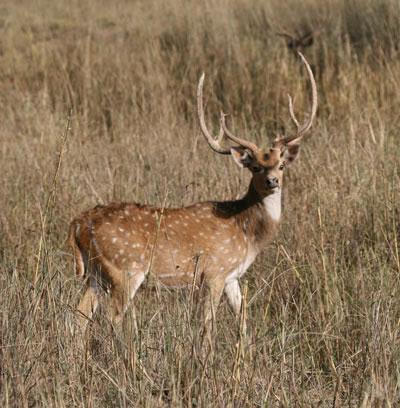
Appearances of the Chital Deer
The Chital is easily recognized by its light brown to dark brown coat with white spots. It also has a creamy underbelly. The deer can blend in with its surroundings, making it a bit more difficult to hunt.
The Chital antler has six points and can grow up to 72cm in height.
Hunting Chital Deer in Australia
Large herds of Chital deer can often be found, sometimes with up to 30 animals. This makes hunting trophy heads difficult. Hunting the Chital deer best when the wind blows is ideal. Avoid disturbing the herd by hunting in the morning. Morning is the best time to hunt, as they tend to sleep in the hottest hours of the day. A Chital with a telescopic view is the best calibre.
Hog deer (Axis porinus)
Hog deer have very specific habitat needs and have thus remained close to their original release areas in 1865. Hog deer need thick cover that is close to marshes and wetlands. Hog deer are the smallest Australian deer and hunting is restricted.
An adult stag weighs in at just 45kg. As a result, its antlers can only reach 35cm. Although hog deer’s coats are brown throughout, they can take on a reddish hue in the summer. The hog deer’s face usually gets greyer as they age.
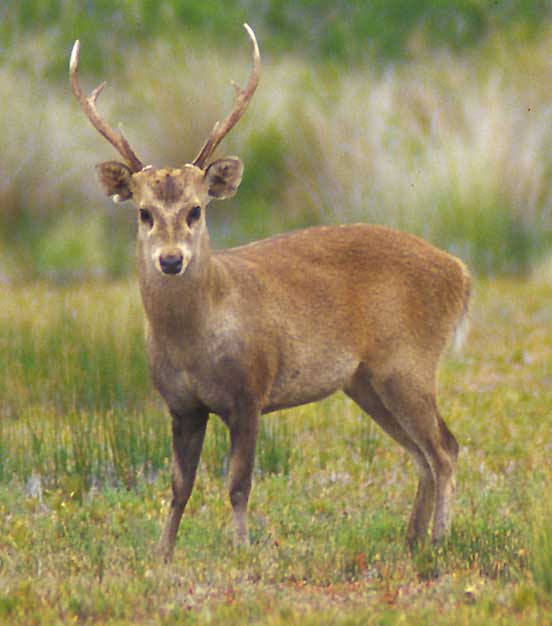
Appearances of the Hog Deer
A mature hog deer adult stag will weigh approximately 45 kg. This is the smallest of our deer. The stags are uniformly brown with a reddish-tinged coat in the summer. Hunting is difficult for older stags because they have a smaller habitat. Hunting activities are restricted and there is a limit to how many stags and hinds hunters can hunt. Hunting season is generally declared in April. It is important to note that each deer taken must be done by a licensed hunter, and must be tagged.
Hog deer tend to congregate in small groups, and eat both in the morning and in the evening. They can become nocturnal if they feel threatened and will usually sleep close to their feeding areas. Tree stands placed over water holes are an effective way to hunt hog deer. These animals are intelligent and skittish so patience is a must.
Hunting the Hog Deer In Australia
Although hunting opportunities for the Hogdeer are limited, the Blond Bay Hog Deer Advisory Group gives each year access to a great hunting habitat. They also offer guided hunts on Sunday Island. Hog deer require a minimum of.243 Winchester.
